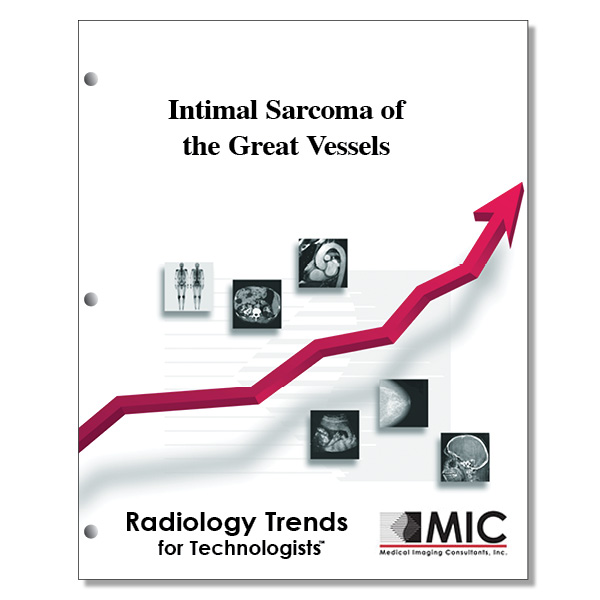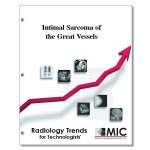

Intimal Sarcoma of the Great Vessels
Intimal sarcomas of the pulmonary artery and aorta are often misinterpreted as pulmonary thromboembolism. This review presents distinguishing imaging features to improve accurate and timely diagnosis.
Course ID: Q00666 Category: Radiology Trends for Technologists Modalities: Cardiac Interventional, CT, MRI, Nuclear Cardiology, Nuclear Medicine, PET, Radiation Therapy, Sonography2.5 |
Satisfaction Guarantee |
$29.00
- Targeted CE
- Outline
- Objectives
Targeted CE per ARRT’s Discipline, Category, and Subcategory classification:
[Note: Discipline-specific Targeted CE credits may be less than the total Category A credits approved for this course.]
Cardiac-Interventional Radiography: 2.00
Procedures: 2.00
Diagnostic and Conduction System Studies: 2.00
Computed Tomography: 2.50
Procedures: 2.50
Neck and Chest: 2.50
Magnetic Resonance Imaging: 2.50
Procedures: 2.50
Body: 2.50
Nuclear Medicine Technology: 2.50
Procedures: 2.50
Endocrine and Oncology Procedures: 2.50
Radiography: 2.00
Procedures: 2.00
Thorax and Abdomen Procedures: 2.00
Registered Radiologist Assistant: 2.50
Procedures: 2.50
Neurological, Vascular, and Lymphatic Sections: 2.50
Vascular-Interventional Radiography: 2.00
Procedures: 2.00
Vascular Diagnostic Procedures: 2.00
Outline
- Introduction
- Clinical Presentation
- Pulmonary Artery Sarcoma
- Aortic Intimal Sarcoma
- Imaging of Intimal Sarcomas
- Pulmonary Artery Sarcoma
- Chest Radiography
- Computed Tomography
- Magnetic Resonance Imaging
- 18F-FDG PET/CT
- Other Imaging Modalities
- Summary
- Aortic Intimal Sarcoma
- Chest Radiography
- Computed Tomography
- Magnetic Resonance Imaging
- 18F-FDG PET/CT
- Other Imaging Modalities
- Summary
- Pulmonary Artery Sarcoma
- Treatment Approaches
- Pulmonary Artery Sarcoma
- Aortic Intimal Sarcoma
- Pathologic Findings of Intimal Sarcomas and Radiologic Correlation
- Pulmonary Artery Sarcoma
- Aortic Intimal Sarcoma
- Conclusion
Objectives
Upon completion of this course, students will:
- state the average survival rate for aortic intimal sarcoma
- list the decades of life in which pulmonary artery sarcoma and aortic intimal sarcoma are diagnosed
- list the decades in life in which pulmonary artery sarcoma and aortic intimal sarcoma have been reported
- list the arteries in which intimal sarcomas of the peripheral arteries tend to arise
- describe the symptoms of pulmonary artery sarcoma
- state the definitive treatment for pulmonary artery sarcoma
- state where the largest study cohorts of patients with aortic intimal sarcoma can be found
- recall the average age of diagnosis for aortic intimal sarcoma
- give the most common location for aortic intimal sarcoma
- list the common sites for arterial embolism in aortic intimal sarcoma patients
- list the locations where pulmonary artery sarcoma normally arise
- state unusual conditions that mimic pulmonary artery sarcoma
- list the imaging modalities that help to distinguish pulmonary artery sarcoma from other entities
- choose the most appropriate imaging modalities for the initial detection of pulmonary artery sarcoma
- describe how tumor margins of pulmonary artery sarcoma appear at computed tomography
- state where pulmonary artery sarcoma normally originates
- choose which imaging modalities show the “wall eclipsing” sign
- state imaging findings at computed tomography that most clearly help differentiate pulmonary artery sarcoma from thromboembolic disease
- describe the appearance of a saddle embolism at computed tomography
- describe shared imaging findings for pulmonary artery sarcoma and chronic thromboembolic disease
- describe the appearance of pulmonary artery sarcoma at contrast-enhanced magnetic resonance imaging
- choose the two imaging modalities that combined provide the most reliable method of distinguishing pulmonary artery sarcoma from alternative benign diagnoses
- state the types of echocardiography that may demonstrate signs of pulmonary hypertension, including absent or altered flow in the pulmonary artery and elevated right heart pressures
- describe the appearance of pulmonary artery sarcoma at angiography
- list the areas where intimal sarcomas have been reported
- recall how aortic intimal sarcoma is often misdiagnosed
- list the sites of metastatic disease associated with aortic intimal sarcoma
- describe the radiographic appearance of aortic intimal sarcoma
- describe what the term “shaggy aorta” means
- describe computed tomography features that discern neoplasia from benign entities
- state how magnetic resonance imaging is superior to computed tomography when imaging aortic intimal sarcoma
- choose the imaging modalities that offer multiplanar reformation evaluation to facilitate surgical planning for aortic intimal sarcoma
- choose the most appropriate imaging modalities to further assess lesion characterization when intimal sarcoma is suspected
- list the main treatment options for pulmonary artery sarcoma resection
- state the percentage of patients with aortic sarcoma that have metastatic disease at the time of diagnosis
